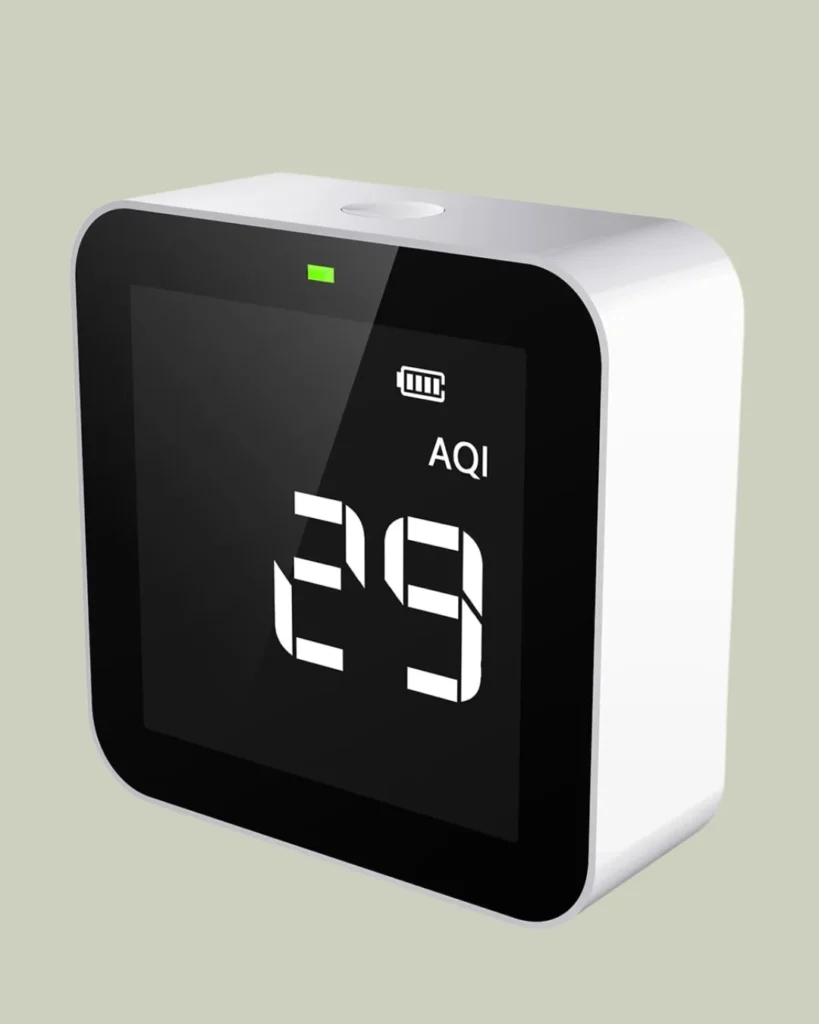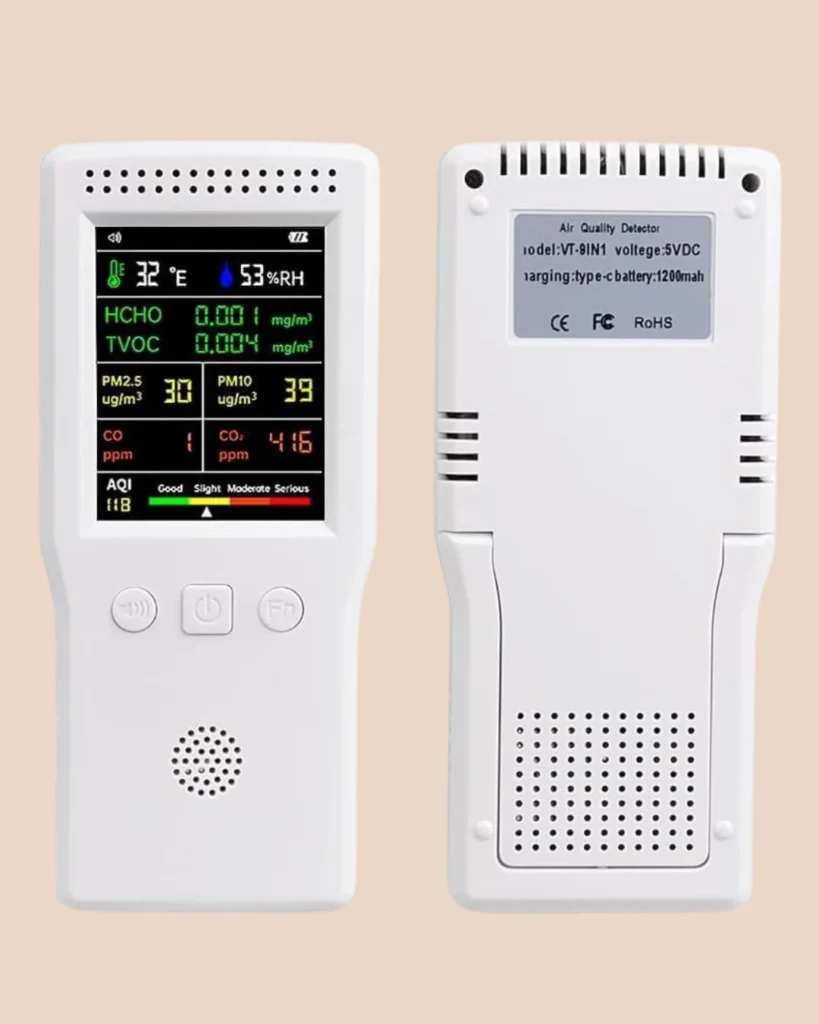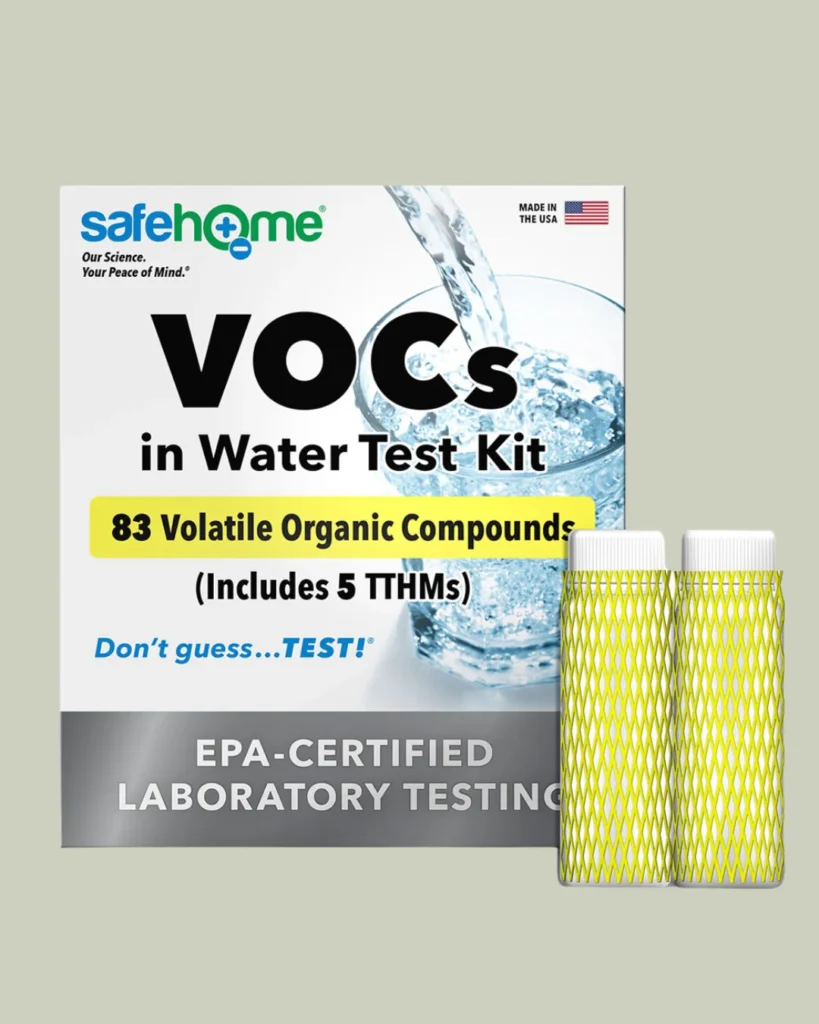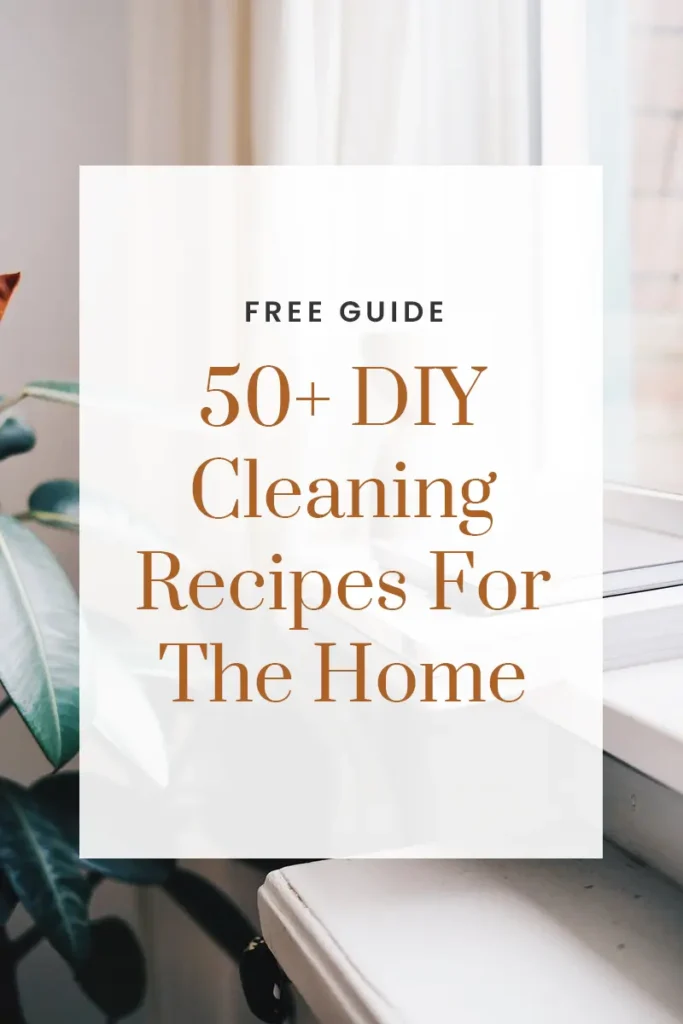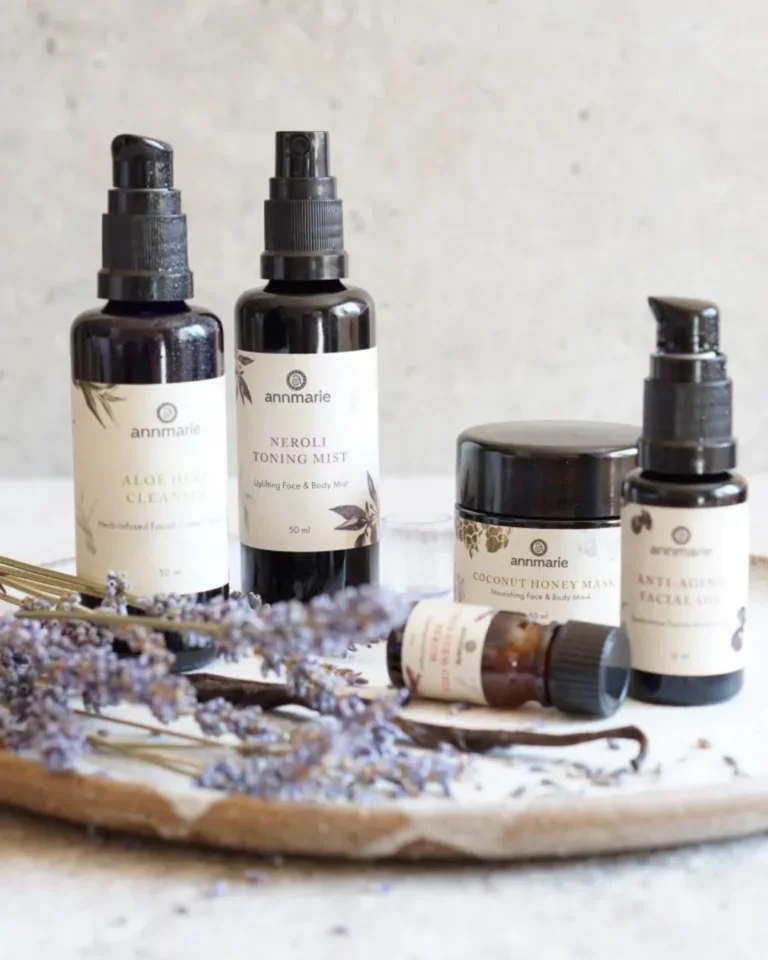SKL is reader supported. When you buy through links on our site, we may earn affiliate commission. Learn more here.
Did you know that indoor air can be up to five times more polluted than outdoor air? Shocking, I know. From that fresh coat of paint on your walls to the sweet-smelling air fresheners in your bathroom, VOCs are hiding in plain sight.
According to the EPA, concentrations of many VOCs are consistently higher indoors (up to ten times higher) than outdoors. Considering we spend about 90% of our time indoors, this is a big deal.
The very place you consider your safe haven might be filled with invisible substances known as VOCs (Volatile Organic Compounds).
In this guide, we’ll help you understand what VOCs are used for, how to reduce VOCs at home, and how to test VOC levels.
We’ll also share our favorite non-toxic alternatives for most chemical-packed everyday personal care and home products.
P.S. Don’t forget to check out the best ways to test for lead exposure at home.

The Ultimate Guide to Vocs, How to Reduce Them & How to Test Voc Levels in Your Home
If you’ve been a part of the sustainable living world for a while, you’ve probably heard the term “VOCs” tossed around or seen labels proudly proclaiming “VOC-free” on various products like Zero VOC Paint. But do you know what those mysterious substances actually are?
Unfortunately, the truth is that most people have been exposed to VOCs without even realizing it. You just finished cleaning your kitchen with your favorite disinfectant, and your living room boasts a brand-new carpet. Both of these activities, while seemingly harmless, are introducing VOCs into your home.
And it’s not just cleaning supplies and carpets – VOCs can be emitted from new furniture, personal care products like deodorants and hair sprays, and even the beloved scented candles you light to unwind after a long day.
Minimizing your exposure to VOCs is extremely important, especially if you have children. Kids are more susceptible to the effects of VOCs because their bodies are still developing, and they tend to spend more time indoors.
Scientists shout from the rooftops that prolonged exposure to VOCs can lead to a range of health issues, from minor irritations to serious long-term effects such as respiratory problems and even cancer. That’s why it’s so important to be vigilant about the products you bring into your home.
I’ve been on a mission to create a healthier living environment for my family for years. From outfitting my home with non-toxic furniture to switching to non-toxic cleaning products and personal care items, I’ve made it my goal to reduce VOC exposure as much as possible.
And let me tell you, the peace of mind that comes with knowing your home is a safer, healthier place is absolutely worth it.
What Are VOCs?
Ever walked into a room and thought, “What’s that smell?” You might be nose-to-nose with VOCs! Volatile Organic Compounds — aka VOCs – are a group of organic chemicals that evaporate easily at room temperature.
The Environmental Protection Agency (EPA) defines VOCs as any compound of carbon (excluding carbon monoxide, carbon dioxide, carbonic acid, metallic carbides or carbonates, and ammonium carbonate) that participates in atmospheric photochemical reactions. In simpler terms, these are chemicals that vaporize and mix with the air we breathe.
Some Common Characteristics of VOCs
- High Vapor Pressure: They evaporate quickly, which is why that paint smell hits you fast and hard.
- Low Water Solubility: Most VOCs don’t mix well with water, making them persistent in the environment.
- Varied Health Impacts: From minor irritations to serious health risks, VOCs can be a mixed bag of trouble.
Types of Volatile Organic Compounds Found in Our Homes
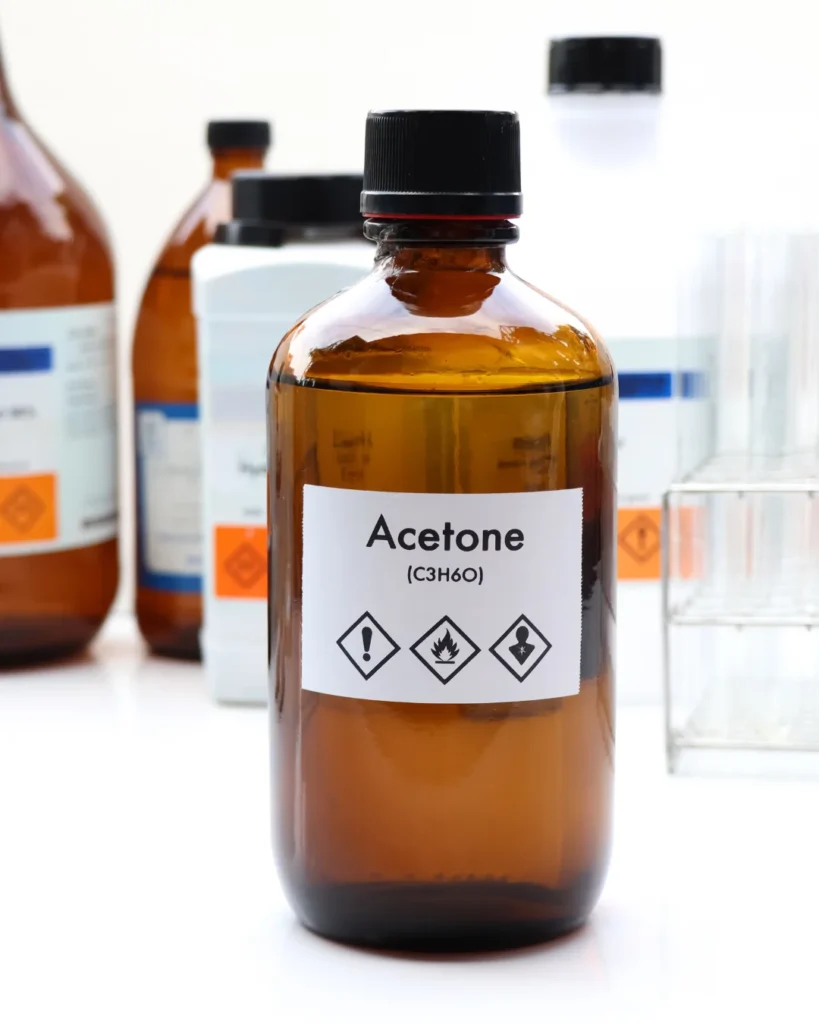
Formaldehyde
Formaldehyde is a colorless, strong-smelling gas used in making building materials and many household products. You’ll find it in items like glues, permanent press fabrics, paper products, and certain insulation materials.
The Environmental Protection Agency (EPA) reports that formaldehyde levels in indoor air are typically higher than outdoor levels, especially in newer homes with significant amounts of pressed wood products.
Another study by the California Air Resources Board found that levels of formaldehyde in new homes were up to 4.5 times higher than in older homes.
This VOC can irritate the skin, eyes, nose, and throat. Long-term exposure may even increase the risk of some types of cancers, according to the National Cancer Institute.
So, if your eyes are watering after setting up that new piece of furniture, formaldehyde might be the culprit.
Benzene
Benzene is another VOC worth knowing about. This sweet-smelling chemical is found in tobacco smoke, stored fuels, and paint supplies. It’s also used to manufacture plastics, resins, and synthetic fibers. While it might seem harmless, benzene is anything but.
The Centers for Disease Control and Prevention (CDC) highlights that long-term exposure to benzene can affect the bone marrow, leading to blood disorders like leukemia.
Even short-term exposure can cause dizziness, headaches, and drowsiness. If you’re using products that emit benzene, good ventilation is your best friend.
Toluene
Toluene is a VOC often found in paint thinners, adhesives, and nail polish. Known for its distinct, pungent smell, toluene can quickly fill a room with fumes.
According to the Agency for Toxic Substances and Disease Registry (ATSDR), exposure to toluene can affect the nervous system, causing symptoms like headaches, dizziness, and, in extreme cases, cognitive impairment. Chronic exposure can also harm the liver and kidneys.
When working with products containing toluene, make sure to keep your space well-ventilated and consider wearing a mask to reduce inhalation.
Xylene
Xylene is present in paint, varnishes, and rust preventives. This VOC is known for its strong, sweet odor.
The National Institute for Occupational Safety and Health (NIOSH) warns us that xylene exposure can cause headaches, dizziness, and respiratory issues. Long-term exposure may result in more serious health effects, including liver and kidney damage.
So, the next time you’re touching up your home with a fresh coat of paint, remember that xylene might be tagging along for the ride.
Acetone
Acetone, the primary ingredient in many nail polish removers, is another common VOC.
While it’s effective at removing nail polish, acetone can also be irritating to the eyes, nose, and throat. Prolonged exposure can lead to headaches, dizziness, and confusion.
The American Conference of Governmental Industrial Hygienists (ACGIH) points out that acetone is less toxic than many other VOCs, but it’s still wise to use it in a well-ventilated area and limit your exposure.
Ethanol
Ethanol, found in household products like window cleaners and disinfectants, is a VOC that many people are familiar with, especially since it’s also found in alcoholic beverages.
While ethanol in beverages is generally safe in moderation, ethanol as a VOC can contribute to indoor air pollution.
The Occupational Safety and Health Administration (OSHA) notes that high levels of ethanol vapor can cause respiratory irritation, headaches, and fatigue.
Keeping your home well-ventilated when using products containing ethanol can help minimize these effects.
What Are the Symptoms of High VOC Exposure?
High exposure to VOCs can be like having an invisible pest in your home—it can cause a variety of symptoms that range from mildly annoying to downright concerning.
- Headaches and Dizziness: Ever feel like your head’s in a fog? High levels of VOCs can leave you with a persistent headache or a sense of dizziness. This happens because some VOCs can interfere with the brain’s oxygen levels, making you feel off-balance and out of sorts.
- Eye, Nose, and Throat Irritation: If your eyes are watering, your nose is stuffy, or your throat feels scratchy, it might not just be allergies or a cold. VOCs can irritate the mucous membranes in these areas, leading to symptoms similar to what you’d get from a dusty room or a whiff of strong perfume.
- Respiratory Issues: VOCs can make breathing feel like a chore. If you’re finding it hard to take a deep breath or experiencing a chronic cough, VOCs might be the culprit. For people with asthma or other lung conditions, exposure can exacerbate symptoms, turning a manageable condition into a more serious issue.
- Nausea and Fatigue: Feeling queasy or unusually tired? VOCs can mess with your stomach and zap your energy, making it hard to enjoy your day. This fatigue can be persistent and unexplained, leaving you feeling drained.
- Skin Reactions: Believe it or not, VOCs can even mess with your skin. Some people experience rashes or other skin irritations from exposure for no apparent reason.
- Serious Long-term Effects: While short-term exposure can be annoying, long-term exposure to high levels of VOCs can lead to more serious health issues. This includes damage to the liver, kidneys, and even the central nervous system. Some VOCs are also suspected carcinogens, which means they could increase your risk of cancer with prolonged exposure.
Where Are Most VOCs Found in the House?

Household Products
Household products like cleaners, air fresheners, and disinfectants are some of the main culprits.
They’re great for keeping your home sparkly clean and smelling fresh, but they often come at a cost. Products like bleach, ammonia, and even some eco-friendly cleaners can release VOCs into the air.
The benefits? They effectively kill germs and eliminate odors. The downside? Frequent use can lead to indoor air pollution, which can cause headaches, dizziness, and even respiratory issues.
So next time you’re scrubbing away, remember that less is more when it comes to chemicals.
Building Materials
Building materials are another big source of VOCs. Paints, varnishes, and carpets might make your home look beautiful, but they can also fill the air with harmful fumes.
Freshly painted walls and new carpets often release VOCs, especially during the first few days after installation. While these materials can transform the aesthetic of your home and improve durability, the side effects can be significant.
VOCs from these materials can cause eye, nose, and throat irritation. They’ve also been linked to more severe health issues like liver and kidney damage.
So make sure to opt for low-VOC or no-VOC options when renovating to keep your home safe and stylish.
Furniture and Decor
Furniture and decor can be surprisingly sneaky when it comes to VOCs. Treated wood, new furniture, and even some home decor items can emit VOCs.
That new couch or bookshelf might look great, but it could be releasing formaldehyde and other VOCs into your living space. The benefits of these items include aesthetic appeal and functionality, but the side effects can be a real drag.
VOCs from furniture can cause allergic reactions and respiratory problems. To reduce exposure, consider buying second-hand furniture or looking for items from non-toxic furniture brands labeled as low-VOC.
Pesticides and Insect Repellents
Pesticides and insect repellents are often necessary evils for keeping bugs at bay. These products are highly effective at eliminating pests, but they’re also a significant source of VOCs. The benefits are clear: a pest-free home without the annoyance of insects.
However, the side effects can be harmful, especially with frequent use. Pesticides can release VOCs that may cause headaches, nausea, and even long-term health effects like nerve damage.
Using natural alternatives or applying pesticides sparingly can help reduce your VOC exposure while still keeping the bugs away.
Personal Care Products
Personal care products like cosmetics, deodorants, and hair sprays are another major source of VOCs. We all love looking our best, but many beauty products contain VOCs that can evaporate into the air.
The benefits? These products help us feel confident and groomed. The downside? Repeated exposure can lead to skin irritation, headaches, and even more serious health concerns over time.
Opting for natural, fragrance-free personal care products can help you look good without compromising indoor air quality.
How Long Do VOCs Last in a Room?
The duration VOCs remain in a room varies widely based on several factors: the type of VOC, the source, the ventilation, and the room’s temperature and humidity. Some VOCs can dissipate within hours, while others might hang around for weeks or even months.
For example, according to the Environmental Protection Agency, VOCs from paints and coatings can continue to off-gas for several days after application, with most VOCs reducing to background levels within 2 to 3 days in well-ventilated areas.
Also, research published in the journal Environmental Science & Technology highlighted that VOCs from new furniture could off-gas for weeks, with significant reductions within the first month, but low-level emissions continuing for years.
How Do You Speed Up VOC Off-Gassing?
First, increase ventilation. Opening windows and doors allows fresh air to circulate, which helps to dilute and remove VOCs more quickly.
Using fans, especially exhaust fans in kitchens and bathrooms can further accelerate this process by actively drawing VOC-laden air out of your home.
Pro Tip: For a more targeted approach, place fans near new items, like furniture or carpets, that might be releasing VOCs, directing the airflow outside.
Another helpful tactic is to raise the temperature in your home temporarily. VOCs evaporate faster at higher temperatures, so by turning up the heat a bit, you can speed up the off-gassing process.
However, don’t overdo it—just a slight increase will do the trick without making your space uncomfortable.
If you’ve recently acquired new items that could be releasing VOCs, consider placing them in a well-ventilated area, like a garage or an unused room, before bringing them into your main living spaces. This off-gassing period can significantly reduce the amount of VOCs you’ll deal with indoors.
Additionally, using low-VOC sealants or finishes on new furniture or flooring can help seal in these compounds, preventing them from off-gassing into your home’s air.
Because prevention is better than cure, let’s go over some easy ways to reduce VOC pollution in your home from the get-go.
How to Reduce VOCs in Your Home
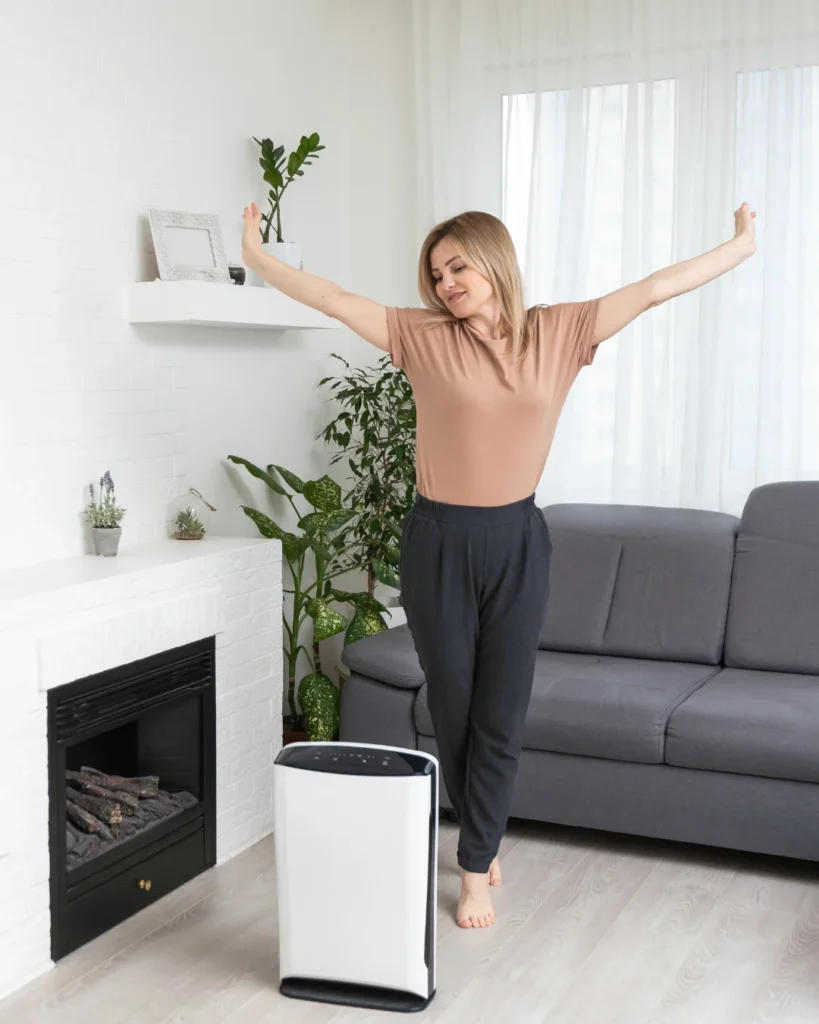
Let Your Home Breath
Fresh air is the ultimate room freshener. Regularly opening windows and doors to let in fresh air can significantly reduce the concentration of VOCs.
Use exhaust fans in kitchens and bathrooms to help vent indoor air pollutants outside. If you’re dealing with new paint or furniture, ventilate the area as much as possible.
Think of ventilation as your home’s way of taking a deep breath – a breath of fresh air that sweeps those VOCs out the door.
Choose Low-VOC or No-VOC Products
When it comes to paints, finishes, and cleaning products, go for the low-VOC or no-VOC options. Many brands now offer eco-friendly products that don’t compromise on quality.
Look for labels that say “low-VOC” or “no-VOC” and make it a habit to read product information before making a purchase.
Regular Cleaning and Maintenance
Dust and vacuum regularly to keep VOCs at bay. Dust particles can carry VOCs, so keeping your home clean can help reduce exposure.
Use a vacuum with a HEPA filter to trap those tiny particles effectively. Regular cleaning not only makes your home sparkle but also cuts down on the buildup of VOCs from dust and debris.
Avoid Air Fresheners and Scented Candles
They may smell nice, but many air fresheners and scented candles are loaded with VOCs.
Instead, opt for natural alternatives like essential oils or simmering spices on the stove. A bowl of baking soda or a few drops of your favorite essential oil on a cotton ball can work wonders for freshening up a room without the chemical overload.
Remember, a fresh-smelling home doesn’t need to come at the cost of clean air.
Houseplants as Natural Air Purifiers
Houseplants are not just for decoration – they can also help purify the air. Plants like the spider plant, snake plant, and aloe vera are known for their air-cleaning abilities.
These green warriors absorb VOCs and other pollutants while giving your home a touch of nature. Think of them as your home’s personal air purifiers, working round the clock to keep the air clean.
Be Mindful of Personal Care Products
Switch to natural, fragrance-free personal care products to reduce VOC exposure. Many cosmetics, deodorants, and hair sprays contain VOCs, but there are plenty of natural alternatives available.
Look for products labeled as “organic,” “natural,” or “fragrance-free.” Your skin and the air you breathe will thank you.
Store Products Properly
Keep products that contain VOCs, like paints, solvents, and cleaning supplies, in tightly sealed containers and store them in a well-ventilated area, preferably outside the main living spaces.
Proper storage can prevent VOCs from leaking into the air when these products are not in use.
Go Green with Your Cleaning Products
Use natural cleaning products whenever possible. Ingredients like vinegar, baking soda, and lemon juice can tackle most household cleaning tasks without releasing VOCs.
These natural cleaners are effective, inexpensive, and much safer for you and the environment. Plus, they smell pretty good too!
How to Test VOC Levels in Your Home
Granted, testing for VOCs in your home might sound like a job for a scientist, but it’s actually something you can do with a bit of guidance and the right tools.
Knowing the VOC levels in your home can help you take the right steps to reduce them and create a healthier living environment.
Temtop M10 is a smart device that helps you keep track of the air quality in your home by measuring four key elements: PM2.5 (tiny particles that can affect your lungs), AQI (Air Quality Index, a general air quality score), HCHO (formaldehyde, a common indoor pollutant), and TVOC (total volatile organic compounds, which can include a range of harmful gases).
You can thank the sensitive PM2.5 laser sensor and a British Dart formaldehyde sensor for the highly accurate readings.
This 9-in-1 Air Quality Monitor is a handy device that checks the air in your home for harmful substances and gives you real-time updates.
It uses advanced sensors to measure various pollutants, including CO2 (carbon dioxide), CO (carbon monoxide), HCHO (formaldehyde), TVOC (total volatile organic compounds), PM2.5 and PM10 (particulate matter), and the overall Air Quality Index (AQI). It also tracks temperature and humidity levels.
What’s more, the monitor has an easy-to-read display that shows both digital numbers and colored bars, helping you quickly understand the air quality.
Plus, it doesn’t require any apps or Wi-Fi—just turn it on, and it starts measuring right away.
This Safe Home VOCs test can detect 83 Volatile Organic Compounds (VOCs), including TTHMs (Total Trihalomethanes) and Vinyl Chloride, ensuring a comprehensive check for potential contaminants in your water supply.
Your water sample will be analyzed by certified scientists using advanced, certified laboratory equipment.
Plus, unlike field test kits or test strips, which can be prone to errors, this professional analysis offers a much higher level of accuracy and reliability.
4. Professional Indoor Air Quality Testing
The most foolproof way to test your home for VOCs is, of course, with the help of a certified professional.
If you’re experiencing health symptoms like headaches, dizziness, or respiratory issues that you suspect might be related to indoor air quality, or if you’re planning a major renovation, professional testing is a wise choice.
It’s also beneficial if your DIY test results show high levels of VOCs and you need a more detailed analysis.
Look for certified indoor air quality professionals or environmental consultants. Make sure to check their credentials and read reviews before scheduling an appointment.
The professional will visit your home to conduct the testing. They’ll use specialized equipment to measure VOC levels in different areas of your home and can also identify sources of VOCs and offer tailored recommendations for reducing exposure.
This equipment is often more sensitive and accurate than DIY kits.
After the testing, you’ll receive a comprehensive report detailing the findings. This report will include the types and concentrations of VOCs detected, potential sources, and specific steps to reduce VOC levels.
Can air purifiers detect VOCs?
Air purifiers themselves don’t typically “detect” VOCs; instead, they are designed to remove or reduce them from the air. Detection is usually done using specialized air quality monitors or sensors.
However, some advanced air purifiers come with built-in air quality sensors that can provide feedback on general air quality, including VOC levels.
It’s important to note that while these sensors can indicate the presence of VOCs, they don’t usually specify which VOCs are present or in what concentration.
The main function of air purifiers is to use filters (like activated carbon filters) to absorb or neutralize VOCs, thereby improving indoor air quality.
Why are VOCs worse at night?
Many people close windows and doors at night, reducing the natural ventilation that helps disperse VOCs during the day. This limited airflow can cause VOC concentrations to build up indoors.
Additionally, indoor temperatures can drop at night, potentially slowing down the dispersion of VOCs. Some VOCs might also off-gas more slowly in cooler conditions, which can lead to their accumulation.
Lastly, during the day, activities like cooking, cleaning, or simply moving around can help circulate air. At night, when these activities decrease, the air can become more stagnant, allowing VOCs to concentrate.
What kills VOCs?
- Activated Carbon Filters: These filters are excellent at adsorbing VOCs due to their porous structure, which traps the chemicals as air passes through.
- Air Purifiers with UV-C Light: While UV-C light is mainly used to kill bacteria and viruses, it can also help break down certain VOCs when used in combination with other filtration systems.
- Photo Catalytic Oxidation (PCO): This technology uses a catalyst, typically titanium dioxide, and UV light to convert VOCs into harmless compounds like carbon dioxide and water.
- Plants: Certain houseplants can absorb VOCs and are a natural way to help purify indoor air. Plants like spider plants, peace lilies, and Boston ferns are known to be effective at reducing VOCs.
- Ventilation and Air Exchange: Increasing ventilation by opening windows and using exhaust fans can help dilute indoor VOCs and replace them with fresh outdoor air.
This was our guide to VOCs, how to reduce them & how to test VOC levels in your home.
In conclusion, VOCs are always hiding in plain sight, but they’re no joke when it comes to your health.
From causing headaches and respiratory issues to posing long-term health risks, high VOC exposure is something we all should be mindful of.
The good news? Reducing your VOC exposure is easier than you might think! By making a few simple swaps—like choosing low-VOC products, upping your ventilation game, and embracing natural cleaning solutions—you can significantly improve your indoor air quality.
Remember, awareness is the first step toward a healthier home. Knowing what VOCs are and how to minimize them helps you create a safer environment for yourself and your loved ones.
 Enter To Win An Organic Luxury Mattress From PlushBeds!
Enter To Win An Organic Luxury Mattress From PlushBeds! 